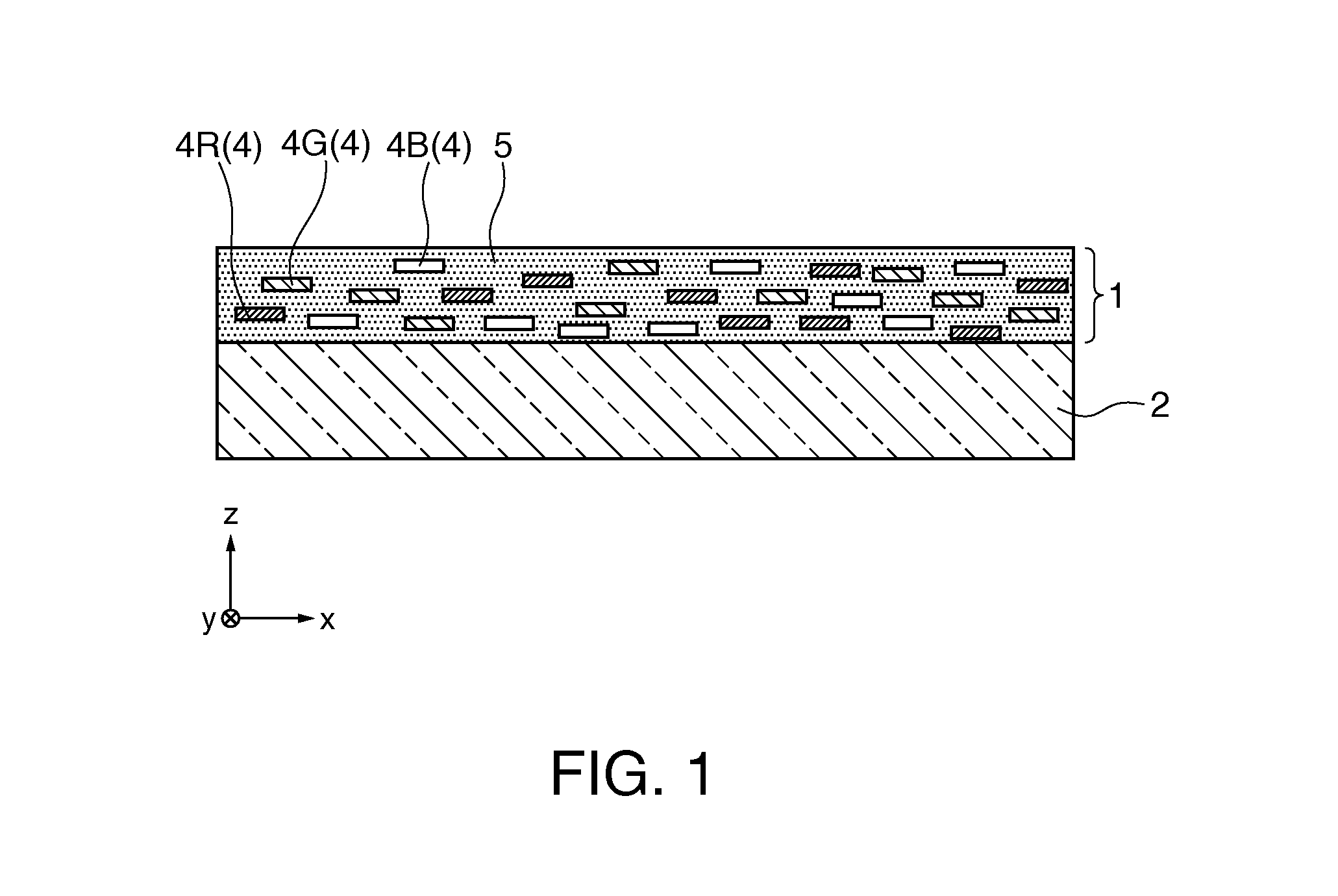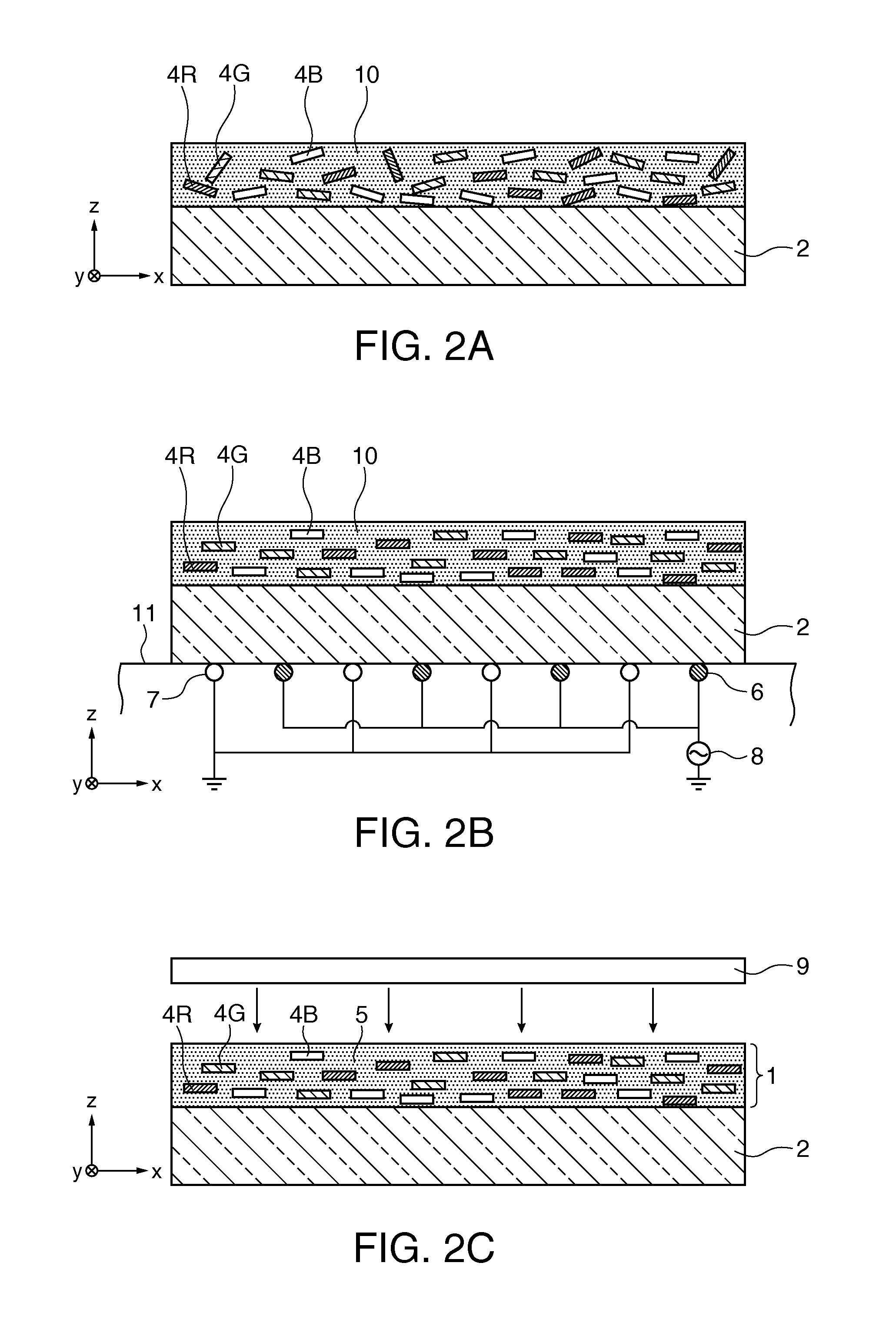Polarizing element, liquid crystal device, and electronic apparatus
a technology of liquid crystal devices and polarizing elements, applied in the direction of polarizing elements, instruments, optics, etc., can solve the problems of inability to acquire sufficient brightness level, marked light degradation, and inability to achieve sufficient brightness level, etc., to achieve the effect of superior display quality
- Summary
- Abstract
- Description
- Claims
- Application Information
AI Technical Summary
Benefits of technology
Problems solved by technology
Method used
Image
Examples
first embodiment
[0046]Hereinafter, a first embodiment of the invention will be described with reference to FIG. 1 and FIGS. 2A to 2C.
[0047]FIG. 1 is a cross-sectional view showing a polarizing element according to this embodiment. FIGS. 2A to 2C are cross-sectional views showing the process of manufacturing the polarizing element according to this embodiment in order.
[0048]In the following drawings, in order to allow each constituent element to be visually recognized in an easy manner, the scale of the size of the constituent element may be differently illustrated.
[0049]The polarizing element 1 according to this embodiment, as shown in FIG. 1, is supported by a glass substrate 2 as a base material. A specific material of the glass substrate 2 is not particularly limited, and any type of known glass substrate may be used. In addition, as long as the substrate has a light transmitting property, it is not limited to a glass substrate, and a quartz crystal substrate, a sapphire substrate, a resin subst...
second embodiment
[0072]Hereinafter, a second embodiment of the invention will be described with reference to FIG. 3.
[0073]The basic configuration of the polarizing element according to this embodiment is similar to that according to the first embodiment, but only the configuration of the polarizing layer is different from that of the first embodiment.
[0074]FIG. 3 is a cross-sectional view showing the polarizing element according to this embodiment.
[0075]In FIG. 3, the same reference numeral is assigned to the constituent element that is common to that of the first embodiment shown in FIG. 1, and detailed description thereof will not be presented here.
[0076]As the polarizing element 1 according to the first embodiment, the polarizing element 1 of one layer is formed on the glass substrate 2. In contrast to this, the polarizing element 21 according to this embodiment, as shown in FIG. 3, includes a glass substrate 2 (base material) as a base material and a polarizing layer 12B, a polarizing layer 12G,...
third embodiment
[0080]Hereinafter, a third embodiment of the invention will be described with reference to FIG. 4.
[0081]The basic configuration of the polarizing element according to this embodiment is similar to that according to the second embodiment, but only the configuration of the third polarizing layer is different from that of the second embodiment.
[0082]FIG. 4 is a cross-sectional view showing the polarizing element according to this embodiment.
[0083]In FIG. 4, the same reference numeral is assigned to the constituent element that is common to that of the second embodiment shown in FIG. 3, and detailed description thereof will not be presented here.
[0084]The polarizing element 23 according to this embodiment, as shown in FIG. 4, includes a glass substrate 2 (base material) as a base material and a polarizing layer 12B, a polarizing layer 12G, and a polarizing layer 13R that are stacked on one face of the glass substrate 2. A first polarizing layer 12B, a second polarizing layer 12G, and a ...
PUM
| Property | Measurement | Unit |
|---|---|---|
| softening point | aaaaa | aaaaa |
| viscosity | aaaaa | aaaaa |
| temperature | aaaaa | aaaaa |
Abstract
Description
Claims
Application Information
 Login to View More
Login to View More - R&D
- Intellectual Property
- Life Sciences
- Materials
- Tech Scout
- Unparalleled Data Quality
- Higher Quality Content
- 60% Fewer Hallucinations
Browse by: Latest US Patents, China's latest patents, Technical Efficacy Thesaurus, Application Domain, Technology Topic, Popular Technical Reports.
© 2025 PatSnap. All rights reserved.Legal|Privacy policy|Modern Slavery Act Transparency Statement|Sitemap|About US| Contact US: help@patsnap.com



